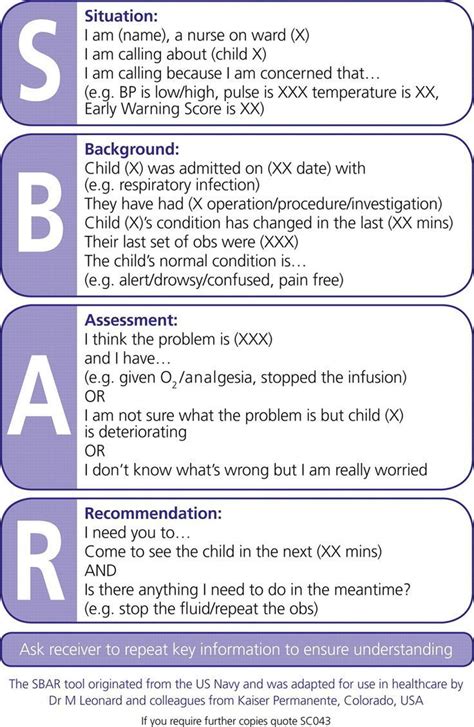Using The Sbar Method In Nursing: Examples & Steps

As a nurse, effective communication is crucial in providing optimal care for patients. The SBAR method is a structured way of communicating critical information that can help improve patient safety and outcomes. SBAR stands for Situation, Background, Assessment, and Recommendation, and it provides a framework for clear and concise communication between healthcare professionals. In this article, we will explore examples and steps of using the SBAR method in nursing.
1. Understanding the SBAR Method
The SBAR method is a communication tool that was originally developed by the military to improve the transfer of critical information. It has since been adapted for use in healthcare settings, particularly in nursing. The method provides a systematic approach to communication, ensuring that important details are not overlooked and that information is conveyed accurately and efficiently.
Example:
Let’s say you are a nurse in a hospital and need to communicate a change in a patient’s condition to the doctor. Using the SBAR method, you would:
- Situation: State the current situation or problem. For example, “I am calling to report a change in Mr. Smith’s vital signs. His blood pressure has dropped significantly.”
- Background: Provide relevant background information. This may include the patient’s medical history, recent test results, or any recent interventions. For example, “Mr. Smith is a 65-year-old male with a history of hypertension. He was admitted to the hospital yesterday with complaints of chest pain. He has been receiving IV fluids and pain medication.”
- Assessment: Share your assessment findings. This may include physical assessment findings, lab results, or changes in the patient’s condition. For example, “Upon assessment, I noticed that Mr. Smith is pale and diaphoretic. His heart rate has increased, and he is complaining of increased chest pain.”
- Recommendation: Make a recommendation for action. This may include requesting a specific intervention, consulting with a specialist, or suggesting a change in treatment plan. For example, “Based on these findings, I recommend that Mr. Smith be seen by the doctor immediately to assess for possible cardiac complications.”
2. Benefits of Using the SBAR Method
The SBAR method offers several benefits in nursing practice:
- Improves communication: By providing a structured format, the SBAR method ensures that important information is conveyed accurately and efficiently.
- Enhances patient safety: Clear communication reduces the risk of errors and improves patient outcomes.
- Streamlines decision-making: The SBAR method helps healthcare professionals make informed decisions by providing a comprehensive picture of the patient’s condition.
- Increases collaboration: Effective communication fosters collaboration among healthcare team members, leading to improved patient care.
3. Implementing the SBAR Method in Nursing Practice
To effectively implement the SBAR method in nursing practice, consider the following steps:
Step 1: Familiarize Yourself with the SBAR Method
Take the time to understand the key components of the SBAR method and how it can be applied in your specific healthcare setting. Familiarize yourself with the four elements: Situation, Background, Assessment, and Recommendation.
Step 2: Use Standardized SBAR Forms
Many healthcare organizations provide standardized SBAR forms that can be used to document and communicate information. These forms typically include sections for each component of the SBAR method, making it easier to organize and convey critical information.
Step 3: Practice SBAR Communication
Take every opportunity to practice using the SBAR method in your daily nursing practice. This can include role-playing scenarios with colleagues or participating in simulation exercises. The more you practice, the more comfortable and confident you will become in using the SBAR method.
Step 4: Seek Feedback
Ask for feedback from experienced healthcare professionals or mentors to help improve your SBAR communication skills. They can provide valuable insights and suggestions for improvement.
Step 5: Continuously Evaluate and Improve
Regularly evaluate your use of the SBAR method and look for areas of improvement. Reflect on your communication skills and seek opportunities to further enhance your ability to convey critical information effectively.
4. Frequently Asked Questions (FAQs)
Q: Can the SBAR method be used in other healthcare professions?
A: Yes, the SBAR method can be used by healthcare professionals such as physicians, pharmacists, and respiratory therapists to improve communication and patient safety.
Q: Are there any limitations to using the SBAR method?
A: While the SBAR method is a valuable communication tool, it is important to recognize that it is not a substitute for comprehensive clinical judgment and assessment. It should be used as a supplement to other forms of communication.
Q: How can the SBAR method be adapted for telephone communication?
A: When using the SBAR method for telephone communication, it is important to provide clear and concise information. Speak slowly and clearly, and ensure that the receiver understands the key points of your communication.
Q: Can the SBAR method be used in non-clinical settings?
A: Yes, the SBAR method can be adapted for use in non-clinical settings such as business or educational environments. It provides a structured approach to communication that can enhance clarity and understanding.
In conclusion, the SBAR method is a valuable tool in nursing practice that improves communication, enhances patient safety, streamlines decision-making, and increases collaboration. By following the steps outlined above and practicing the SBAR method in your daily practice, you can become a more effective communicator and provide better care for your patients.
